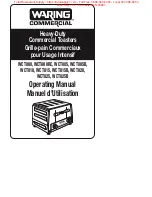
30
3.8. EARTH MEASUREMENT ON LIVE CIRCUIT (Z
A
, R
A
)
This function is used to make an earth resistance measurement in a place where it is impossible to make a 3P earth measurement
or to disconnect the earth connection strap, often the case in an urban environment.
This measurement is made without disconnecting the earth, with only one additional rod, saving time with respect to a conven-
tional earth measurement with two auxiliary rods.
In the case of a TT type installation, this measurement is a very simple way to measure the earth of frame grounds.
In the case of a TN type installation, to determine the value of each of the earths put in parallel, it is necessary to perform a se-
lective earth measurement on live circuit using a current clamp (see §3.9). Without this clamp, what you find is the value of the
global earth connected to the network, which is rather meaningless.
It is then more useful to measure the loop impedance to size the fuses and RCDs, and to measure the fault voltage to check the
protection of persons.
3.8.1. DESCRIPTION OF THE MEASUREMENT PRINCIPLE
The device starts by making a loop measurement Z
S
(see §3.6) with a low current or a high current, at the user’s discretion. It
then measures the potential between the PE conductor and the auxiliary rod and from it deduces R
A
= U
PI-PE
/I, I being the current
chosen by the user.
For greater accuracy, it is possible to make the measurement with a high current (TRIP mode), but this measurement may trip
the RCD of the installation.
3.8.2. MAKING A MEASUREMENT
Set the switch to Z
S
(R
A
/S
EL.
).
At the time of connection, the device detects the positions of the phase (L)
and of neutral (N) with respect to the protective conductor (PE) and displays
them. If necessary, it then automatically switches the L and N terminals so
that the loop measurement can be made without modifying the connections
of the terminals of the device.
If possible, first disconnect all loads from the network on which you make the earth
measurement on line circuit.
It is possible to eliminate this step if you use a measurement current of 6 mA, which
allows a leakage current of up to 9 mA for an installation protected by a 30 mA re-
sidual current device.
Plant the auxiliary rod at a distance of more than 25 metres from the earth electrode and
connect it to the
(R
A
S
EL
) terminal of the device. The
symbol is then displayed.
Case of a TT installation
Case of a TN installation
SET UP
OFF
L
PE
N
Rb
R
N
R
L
Ra
> 25 m
Connect the measuring cable to the device, then to the socket outlet of the instal-
lation to be tested.
L
PE
N
Rb
R
E
R
N
R
L
PE
Ra
> 25 m
















































